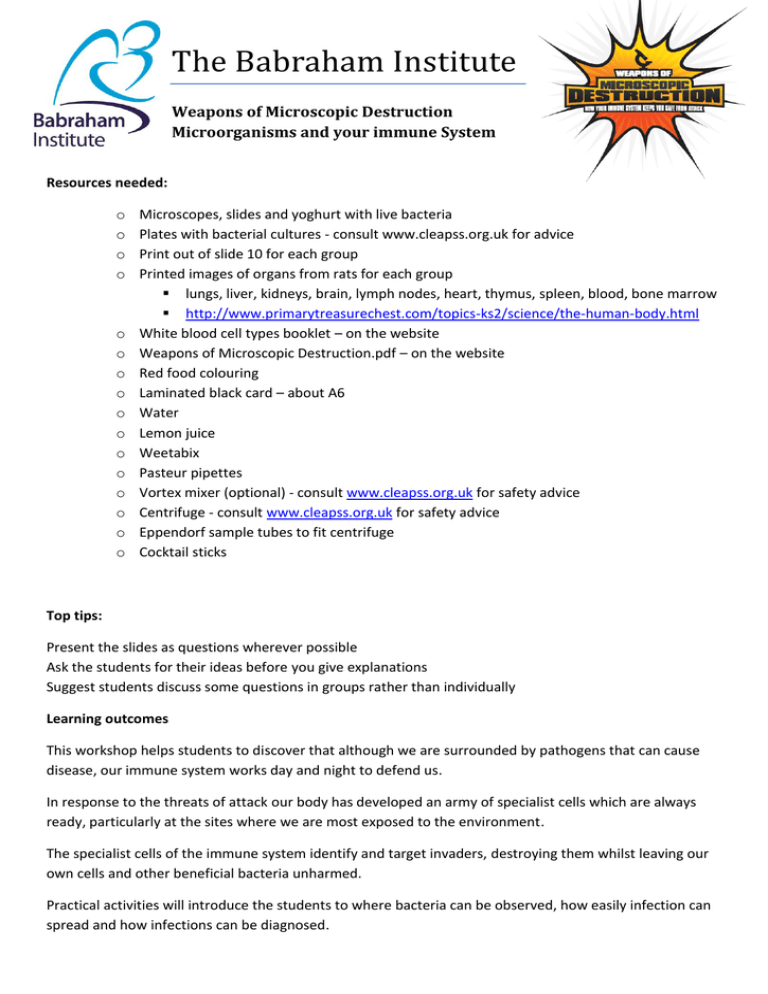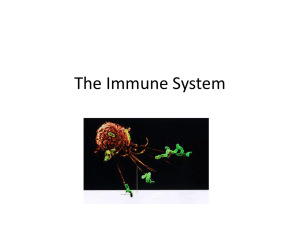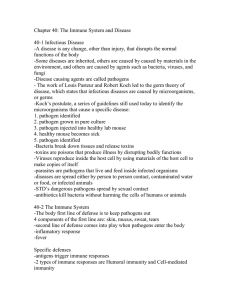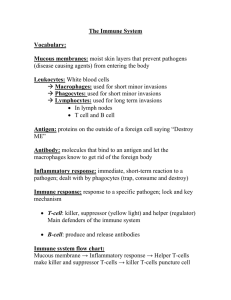Secondary School Immunology activity notes
advertisement

The Babraham Institute Weapons of Microscopic Destruction Microorganisms and your immune System Resources needed: o o o o o o o o o o o o o o o o Microscopes, slides and yoghurt with live bacteria Plates with bacterial cultures - consult www.cleapss.org.uk for advice Print out of slide 10 for each group Printed images of organs from rats for each group lungs, liver, kidneys, brain, lymph nodes, heart, thymus, spleen, blood, bone marrow http://www.primarytreasurechest.com/topics-ks2/science/the-human-body.html White blood cell types booklet – on the website Weapons of Microscopic Destruction.pdf – on the website Red food colouring Laminated black card – about A6 Water Lemon juice Weetabix Pasteur pipettes Vortex mixer (optional) - consult www.cleapss.org.uk for safety advice Centrifuge - consult www.cleapss.org.uk for safety advice Eppendorf sample tubes to fit centrifuge Cocktail sticks Top tips: Present the slides as questions wherever possible Ask the students for their ideas before you give explanations Suggest students discuss some questions in groups rather than individually Learning outcomes This workshop helps students to discover that although we are surrounded by pathogens that can cause disease, our immune system works day and night to defend us. In response to the threats of attack our body has developed an army of specialist cells which are always ready, particularly at the sites where we are most exposed to the environment. The specialist cells of the immune system identify and target invaders, destroying them whilst leaving our own cells and other beneficial bacteria unharmed. Practical activities will introduce the students to where bacteria can be observed, how easily infection can spread and how infections can be diagnosed. Slide 1 Welcome students to the workshop, explain that today we’ll be learning about our Immune System - a part of our body that protects us from getting sick (protects us from infections) Slide 2 – What are scientists? We are scientists – we investigate how our bodies work. Each scientist/presenter gives their name and one-liner about their research (make sure that they use very basic language!) Slide 3 - An ice-breaker for the students, especially if this is run by scientists/presenters they don’t know Ask students to talk about themselves Are any of their family members scientists? What is their favourite experiment etc? Slide 4 Introduce the idea that the students are scientists for the day….we are trying to find out what can make us sick and what our bodies to try to stop that happening…pull them into the ‘story’ – put on lab coats if possible Slide 5 What are Microorganisms – introduce the basic facts – why not look up some of your own! They are tiny, small living creatures; we use microscopes to see them. They can be bacteria, viruses, fungi etc. They were on Earth long before dinosaurs, produce a lot of the oxygen we breathe Slide 6 Ask what microorganisms do – emphasis that most of them are NOT harmful But what do they do – these are examples of ‘good’ and ‘bad’. Harmful things: infections, tooth decay (bacteria), making our food rot, causing diseases in plants Helpful things: making antibiotics to fight infections, food/drink production (yoghurt = lactobacillus, bread and beer = yeast), decomposing dead plants, animals etc to their constituent chemicals Slide 7 and 8 Ask where they may be found (a good one for group discussions before answering) Accept pretty much every answer because they’re found everywhere! Slide 10: A 15 – 12 minute activity session (3 groups can rotate around, 5 minutes each activity if equipment is available) Tell the students we’re going to have a look and see if we can find any bacteria here. 1. Put a small amount of glitter gel on the first pupil’s hand and see how many people it can be transferred to by handshakes. This shows how microorganisms can be easily transferred around – emphasise how hand washing is good! 2. Bacteria in food – use microscopes to look at bacteria in yoghurt – emphasises that bacteria can be ‘good’ for you! See http://www2.mrc-lmb.cam.ac.uk/microscopes4schools/yoghurt.php 3. Examine plates of bacterial cultures – consult http://www.cleapss.org.uk/ for advice on this area Slide 10 Group Activity (5 -10 minutes) So, we’ve established that we’re surrounded by microorganisms, they outnumber us and some of them, the pathogens, can be harmful – so why are we not sick all the time? What is it in your body that keeps you safe from attack? All groups have a print out of the character on slide 10 plus images of lungs, liver, kidneys, brain, lymph nodes, heart, thymus, blood (find on Google) The students need to work out what the organs are, where they are in your body and what they do And do they all help keep you safe from attack? Slide 11 – The Answers - discuss Brain, Lungs, Kidneys, Liver, Heart – all have functions in the body which can be discussed, but none are part of the immune system Bone marrow – immune cells are made here Thymus – a gland in the chest which provides a site for the development of T cells. Lymph nodes and lymphatic system – where cells of the immune system congregate/how they travel around the body. The spleen - the largest lymphatic organ, through which the blood is filtered to detect pathogens Blood – another mode of transport for immune system cells Slide 12 – 18: refer to ‘White blood cell types booklet.pdf’ for information Briefly outline the cells of the immune system and their function – as listed on the slides Slide 19: refer to ‘Weapons of Microscopic Destruction.pdf’ for information Talk through how the body responds to a pathogen as Innate responses, adaptive responses, discuss immunological memory in context of vaccinations The adaptive immune system is composed of highly specialised cells and processes which eliminate and prevent pathogen growth. The adaptive immune system can specifically recognise – and remember – each pathogen that our bodies encounter, building up an immunological memory over our lifetime A rapidly activated line of defence that is first to greet any pathogens that get past the physical barriers, such as the skin and mucus membranes, before the adaptive system has had time to mature. Compared to the highly specific adaptive response, the phagocytes and natural killer cells of the innate system work with broadly specific pattern recognition, which picks up unusual molecular signals such as sugars or nucleic acids that indicate the presence of a pathogen. A vaccine is used to raise a memory immune response without the dangerous effects of actually catching the infection, so that a rapid and effective immune response can be mounted when the pathogen is encountered later in life. A vaccine could be a solution of dead pathogens, pathogens modified to be less virulent, or parts of pathogens. Slide 20: refer to ‘Weapons of Microscopic Destruction.pdf’ for information Reiterate the purpose of antibodies and how they interact with a pathogen The main job of B cells is to make antibodies which bind to antigens on the surfaces of pathogens. They are Y- shaped proteins, each with a different ‘variable’ region, the top of the Y shape, where antigenrecognition and binding takes place. These differences mean that our immune system has the potential to produce 10 billion different antibodies. Recombination or shuffling of genes to create variations in the binding site of the antibodies is the first step in generating this huge repertoire. The ‘constant’ region determines the mechanism used to destroy antigens. Antibodies are classified according to their constant region structure and immune function. Your body can make many different antibodies to recognise the different pathogens you might encounter, but each individual B cell will only make antibodies specific to one antigen. When B cells first develop they produce simple antibodies, but later these antibodies can be improved. That works like this; upon infection, B cells that recognise the pathogen will respond with a simple stock of antibodies and start to multiply, producing more and more antibodies. Later B cells in the germinal centres (special structures that can form in your lymph nodes and spleen) can modify their antibodies and compete to produce the ‘best’ antibodies. Helper T cells and dendritic cells present molecules they have taken from the pathogen to the B cells. The B cells with the ‘best’ antibodies are instructed to multiply and then are sent out to attack the pathogen. After a pathogen has been overcome, a few B cells remain in the body as memory B cells, which are long-lived and slow to multiply under normal circumstances, but can expand very rapidly when the same antigen is encountered again. Slides 21: The One Infection story! Explain that one of the band members of ‘One Infection’ has been taken ill, breaking news has come in that ‘Harry Sneeze is’ thought to be infected with contagious bacterial infection Slide 22 He was at was at a concert with thousands of people and he sneezed Slide 23 We need to find out who’s been infected to administer antidote Slide 24 How can we work out who’s infected? (ask for ideas before explaining) Explain the principles of latex agglutination. It is used in clinical laboratories and works on the principle of antigen/antibody binding. Beads are coated in antibodies and incubated with a sample from a patient. Agglutination (clumping of the beads) indicates a positive result. More information can be found at http://en.wikipedia.org/wiki/Latex_fixation_test Slide 25 – Agglutination activity Each student has a patient sample – either: a positive sample from a One Infection band member or a negative sample from someone who wasn’t at the gig and hasn’t been in contact with band Each student also has a positive (where a reaction is expected) and negative control (where it is known that no reaction will take place) to show that the experiment has worked correctly http://en.wikipedia.org/wiki/Scientific_control Prepare in advance Mix Weetabix with red food colouring to make a ‘poo’ sample. Separate 50 % and mix in lemon juice – this is for the ‘infected’ samples ‘Positive’ control (lemon juice 50:50 with water) which will curdle the milk used as agglutination beads, thus giving the effect of a positive ‘clumping’ result ‘Negative’ control (water) Tubes of ‘buffer’ (water) ‘Agglutination beads’ (milk) Each group should have: Randomly infected ‘poo’ samples in tubes with numbers or names to distinguish them Tubes of ‘buffer’ ‘Positive’ and ‘negative’ controls Pasteur pipettes, cocktail sticks and pieces of A6 black card ‘Agglutination beads’ Instructions for students Place a small amount of sample in a centrifuge tube using a coffee stirrer or lolly stick Add a few drops of buffer and use a vortex mixer (follow instructions for safe use) or shake the tube to mix thoroughly Centrifuge (follow instructions for safe use) the samples for 1 minute Drop a small amount of liquid from the sample in the centre of the card, a positive control on the left and a negative control on right of the black card using a pipette, keeping the samples well apart Add in a small amount of latex agglutination beads to each drop using another pipette and stir Observe and ask which samples and controls show signs of clumping – these will be the infected samples. Slide 26 – Share the results See what they are… Slide 27 Round up – what have we learned?







